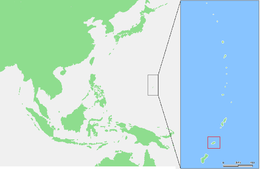Rota (island)
| Native name: Luta | |
|---|---|

Rota Island in Northern Mariana Islands
|
|
| Geography | |
| Location | Pacific Ocean |
| Coordinates | 14°09′13″N 145°12′11″E / 14.15361°N 145.20306°E |
| Archipelago | Marianas |
| Area | 85.38 km2 (32.97 sq mi) |
| Length | 19 km (11.8 mi) |
| Width | 8 km (5 mi) |
| Highest elevation | 495 m (1,624 ft) |
| Highest point | Mount Manira |
| Administration | |
|
United States
|
|
| Commonwealth | Northern Mariana Islands |
| Demographics | |
| Population | 2,477 (2010) |
Rota (Chamorro: Luta) also known as the "Friendly Island", is the southernmost island of the United States Commonwealth of the Northern Mariana Islands (CNMI) and the second southernmost of the Marianas Archipelago. It lies approximately 40 nautical miles (74 km) north-northeast of the United States territory of Guam. Sinapalo village is the largest and most populated followed by Songsong village (Songsong).
Rota is 12.3 miles (19.8 km) long and 4.2 mi (6.8 km) wide. Its coastline is about 38 mi (61 km) long. The highest point on Rota is Mt. Sabana which is 495.56 meters (1,625.9 ft). Rota is 47 nmi (87 km) north of Guam, 63 nmi (117 km) south of Tinian and 73 nmi (135 km) south of Saipan. Rota has diverse flora and fauna.
In 1521, the first European to see Rota was the lookout on Ferdinand Magellan's ship Victoria, Lope Navarro. However, Magellan's armada of three ships did not stop until they reached Guam, so the first European to arrive in Rota (in 1524), was the Spanish navigator Juan Sebastián Elcano, who annexed it together with the rest of the Mariana Islands on behalf of the Spanish Empire.
As with the other islands of the northern Marianas, Rota was sold to the German Empire under the German–Spanish Treaty of 1899. In World War I, the islands were occupied by the Japanese Empire. In 1919, the League of Nations formally recognized Japanese control under the South Pacific Mandate. However, development of Rota lagged behind that of neighboring Tinian and Saipan, with only 1000 Japanese residents arriving by the end of December 1935, most of them employed in raising sugar cane and in sugar refining. The refinery was not economical, and it was closed three years later.
...
Wikipedia

